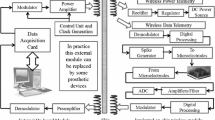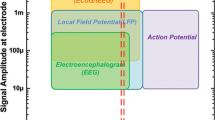Abstract
We present a 32-channel wireless implantable neural recording (WINeR-5) system-on-a-chip (SoC) that operates based on time division multiplexing (TDM) of pulse width modulated (PWM) samples, similar to a single-slope analog to digital converter (ADC) that is made wireless. By transmitting a TDM–PWM signal, we have relaxed the need for wide bandwidth and accurate timing between transmitter and receiver units, which is necessary in wideband digital wireless links. The WINeR-5 system uses FSK modulation scheme with RF carrier at 898/926 MHz. The baseband TDM–PWM signal bandwidth is 18 MHz, which is also the bandwidth of the receiver baseband low-pass filter. Further, by moving the digitization circuitry outside the body, we have reduced the size, complexity, and power consumption of the implantable unit. A clockless asynchronous design has been utilized to manage TDM switching times such that no switching occurs during sensitive PWM onsets. Control over sampling rate, dynamic range, and resolution provides the user with tradeoffs that can optimize the system performance for the intended application. The SoC has been implemented in a 0.5-μm standard CMOS process, measuring 3.3 × 3 mm2 and consuming 5.6 mW at ±1.5 V when all channels are active. Measured input referred noise for the entire system, including the receiver at 1 m distance, is 4.9 μVrms in 1 Hz–8.8 kHz range. Functionality of the WINeR-5 system has also been demonstrated in acute in vivo experiments.



















Similar content being viewed by others
References
Schwartz, A. B., Cui, X. T., Weber, D. J., & Moran, D. W. (2006). Brain-controlled interfaces: Movement restoration with neural prosthetics. Neuron, 52, 205–220.
Nicolelis, M. A. L., & Ribeiro, S. (2002). Microelectrode recordings: The next steps. Current Opinion in Neurobiology, 12, 602–606.
Chae, M., Liu, W., Yang, Z., Chen, T., Kim, J., Sivaprakasam, M., & Yuce, M. (2008). A 128-channel 6 mW wireless neural recording IC with on-the-fly spike sorting and UWB transmitter, Digest of technical papers. IEEE International Solid-State Circuits Conference, pp. 146–147.
Harrison, R. R., Kier, R., Chestek, C., Gilja, V., Nuyujukian, P., Ryu, S., et al. (2009). Wireless neural recording with single low-power integrated circuit. IEEE Transactions on Neural Systems and Rehabilitation Engineering, 17(4), 322–329.
Sodagar, A., Perlin, G., Yao, Y., Najafi, K., & Wise, K. D. (2009). An implantable 64-channel wireless microsystem for single-unit neural recording. The IEEE Journal of Solid-State Circuits, 44(9), 2591–2604.
Goblet, C. A., & Knob, A. (1983). Noise analysis of switched-capacitor networks. IEEE Transactions on Circuits and Systems, 30(1), 37–43.
Yin, M., & Ghovanloo, M. (2009). Using pulse width modulation for wireless transmission of neural signals in multichannel neural recording systems. IEEE Transactions on Neural Systems and Rehabilitation Engineering, 17(4), 354–363.
Yin, M., & Ghovanloo, M. (2009). A flexible clockless 32-ch simultaneous wireless neural recording system with adjustable resolution, Digest of technical papers. IEEE International Solid State Circuits Conference, pp. 432–433.
Harrison, R. R., & Charles, C. (2003). A low-power low-noise CMOS amplifier for neural recording applications. IEEE Journal of Solid-State Circuits, 38, 958–965.
Olsson, R. H., I. I. I., Gulari, M. N., & Wise, K. D. (2005). Band tunable and multiplexed integrated circuits for simultaneous recording and stimulation with microelectrode arrays. IEEE Transactions on Biomedical Engineering, 52(7), 1302–1311.
Olsson, R. H. III, Gulari, M. N., & Wise, K. D. (2003). A fully-integrated bandpass amplifier for extracellular neural recording. Proceedings of the 1st International IEEE EMBS Conference on Neural Engineering, Capri, pp. 165–168.
Horiuchi, T., Swindell, T., Sander, D., & Abshire, P. (2004). A low-power CMOS neural amplifier with amplitude measurements for spike sorting. Proceedings of the IEEE International Symposium on Circuits and Systems, 4, 29–32.
Yin, M., & Ghovanloo, M. (2007). A low-noise preamplifier with adjustable gain and bandwidth for biopotential recording applications. Proceedings of the IEEE International Symposium on Circuits and Systems, pp. 321–324.
Baker, R. J. (2008). CMOS circuit design, layout, and simulation (2nd ed., pp. 909–920). Hoboken, NJ: Wiley/IEEE.
Yin, M., & Ghovanloo, M. (2008). A clockless ultra low-noise low-power wireless implantable neural recording system. Proceedings of the IEEE International Symposium on Circuits and Systems, pp. 1756–1759.
Ghovanloo, M., & Najafi, K. (2005). A compact large voltage compliance high output impedance programmable current source for biomedical implantable microstimulators. IEEE Transactions on Biomedical Engineering, 52(1), 97–105.
Yin, M., & Ghovanloo, M. (2007). Wideband flexible transmitter and receiver pair for implantable wireless neural recording applications. Circuits and Systems, 2007. NEWCAS 2007. IEEE Northeast Workshop, pp. 85–88, Aug 2007.
Yin, M., & Ghovanloo, M. (2008). A wideband PWM-FSK receiver for wireless implantable neural recording applications. Proceedings of the IEEE International Symposium on Circuits and Systems, pp. 1556–1559.
Yin, M., & Ghovanloo, M. (2008). A low-noise receiver for multichannel wireless neural recording. Proceedings of the 1st International IEEE EMBS Conference, pp. 2024–2027.
Yang, H. Y., & Sarpreshkar, R. (2005). A time-based energy-efficient analog-to-digital converter. IEEE Journal of Solid-State Circuits, 40(8), 1590–1601.
Acknowledgments
The authors would like to thank Seung Bae Lee from GT-Bionics lab for helping with system assembly and measurements.
Author information
Authors and Affiliations
Corresponding author
Rights and permissions
About this article
Cite this article
Yin, M., Ghovanloo, M. A low-noise clockless simultaneous 32-channel wireless neural recording system with adjustable resolution. Analog Integr Circ Sig Process 66, 417–431 (2011). https://doi.org/10.1007/s10470-010-9557-6
Received:
Revised:
Accepted:
Published:
Issue Date:
DOI: https://doi.org/10.1007/s10470-010-9557-6




